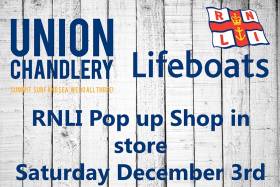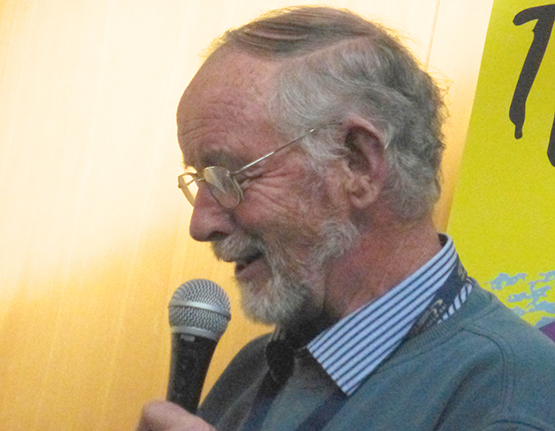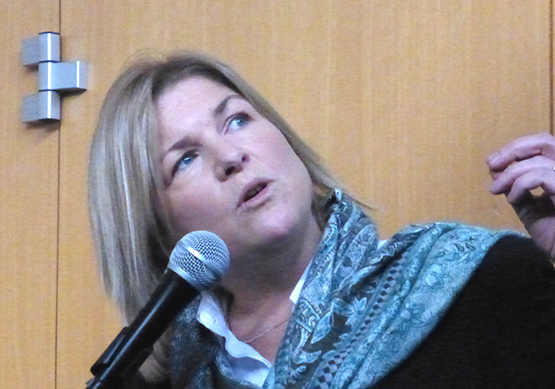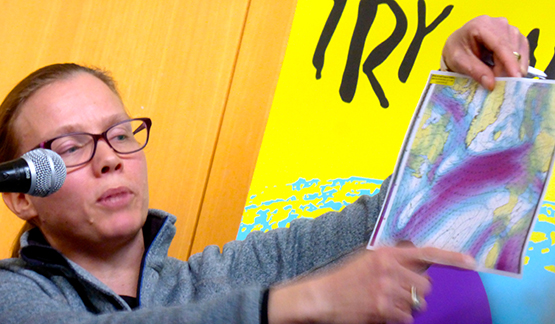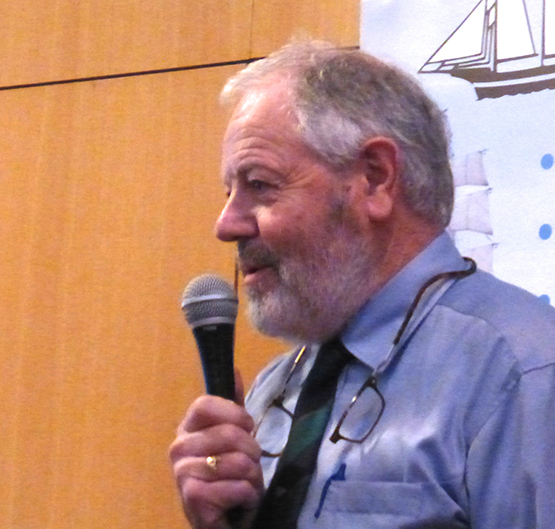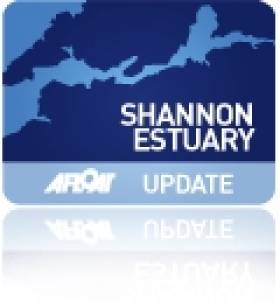Displaying items by tag: Union Chandlery
Union Chandlery Host RNLI Pop–Up Shop This Saturday
This Saturday, Union Chandlery in Cork city will be hosting an RNLI pop–up shop where 100% of the proceeds will be going directly to the RNLI.
These funds are vital for keeping RNLI boats on the water and providing the crews with the lifesaving equipment they use.
The RNLI do not charge for their services and their crews give their time free of charge to save lives at sea. By buying gifts and cards from the RNLI, you are helping to ensure their invaluable service continues to benefit the seafarers of Cork and the rest of Ireland.
Cork has eight lifeboat stations along its coast from Youghal to Castletownbere.
Drop in to Union Chandlery, Penrose Quay on December 3rd to show your support for the amazing work the RNLI do in Cork and further afield. See poster below.
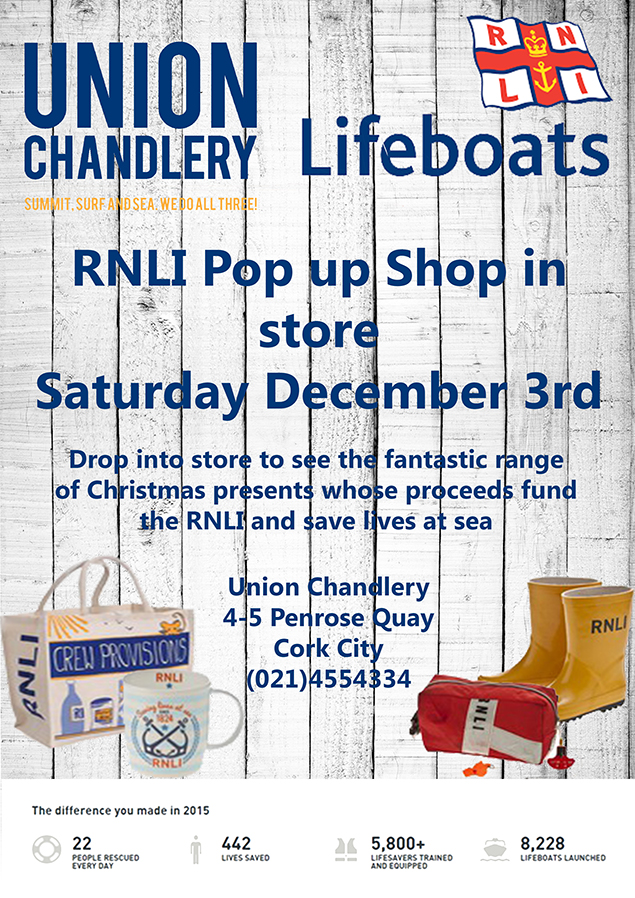
ISA Cruising Conference Was On Target For Topics And Turnout
Last Saturday’s Irish Sailing Association National Cruising Conference, sponsored by Union Chandlery with full organisational support from the Cruising Association of Ireland and the enthusiastic hospitality of Howth Yacht Club, was able to put through a very complete day-long programme which covered an extraordinary variety of topics. Each area of interest was examined in detail by a leading expert – in some cases the CEO of the national agency involved – and by the end the attendees, who came from all over the country, were verging on information overload. Yet everyone finished the day well satisfied, and certainly agreed on one thing – it will be quite something to match the quality of 2016’s Cruising Conference when the next one comes round in 2018. W M Nixon was there, and though he tells us “his head was melted” with the sheer volume of the range of issues discussed and explained, he’ll do his best to let us know what happened.
It went on for seven hours and more, and ranged from the extremities of dealing with calving glaciers in Greenland at one end, to the niceties of lone male watch-keepers dealing safely and efficiently with the calls of nature in mid ocean at the other. And since you ask, there were two distinct camps for dealing with Problem B – those who favour a simple bottle, narrow enough to be stowed in a convenient winch handle holder, and those who think a yoghurt tub with its cover kept usable is your only man, as some folk need a bit of space to perform.
As for the sheer length of the programme, as a group of friends and shipmates attending together we agreed it should have been an hour shorter. But then we couldn’t think of one single item on the agenda that we would have happily discarded. So for 2018 (or next year, if the current plan to make it biennial is reckoned to be wimpishly unambitious), Paddy McGlade the ISA Board Member for Cruising, and Clifford Brown, Commodore of the Cruising Association of Ireland, will have to agree to the same densely-filled programme, and it’s beholden on the participants and the audience to be up for the challenge.
For the fact is, when you get an attendance of this calibre, you need to provide the full coverage in the programe. And if you’re providing the full service in the form of a very comprehensive conference, then you deserve the attendance of all the keenest cruising folk – or would-be cruising folk – in the entire country. And with a comprehensive turnout of 104 enthusiasts where all nvolved on either side of the programe are incuded - when they’d tried initially to keep the numbers manageably at 80 - the dynamic interaction between performers and audience was magic, and ISA President David Lovegrove was properly impressed.
ISA Cruising Convener Gail MacAllister put together a cracking programme, nicely balancing the serious issues which might have had a certain bureaucratic overtone with more overtly entertaining stuff which hit the button either by scaring us stiff, or else making us savour the pure quiet delight of a proper cruise going well with a contented crew on board.
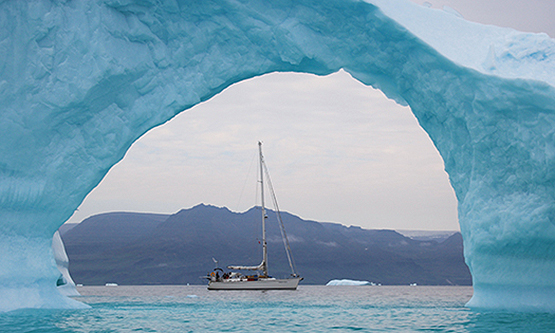
Eddie Nicholson’s Najad 440 Mollihawk’s Shadow in the frame in Greenland. The outline he gave of the pre-planning and execution with shipmates Mike Hodder and Dermot O’Morchoe of this exemplary cruise from Newfoundland eventually home to Ireland was to set the tone for the ISA Cruising Conference.
The tone was set from the start with the all-singing all-dancing account of Eddie Nicholson of Kinsale’s cruise to West Greenland and then on to Ireland from Labrador with the Najad 440 Mollihawk’s Shadow. This was much more than the narrative of an ambitious cruise. Combined with his two leading shipmates Mike Hodder and Dermot O’Morchoe, Eddie makes up a threesome of complementary talents, and their thoughtful account of what goes into planning, preparing and making such a cruise the outstanding success it clearly became was shown in the concluding informative account of what they achieved, once they’d made the effort to put everything in place.
This was obviously at the more advanced end of cruising, so as a balance we next heard from ISA Board Member Pierce Purcell of Galway, who has been on a personal crusade to fire up the interest of all recreational boat owners around Galway Bay. He runs a chandlery at Clarinbridge, and the sheer variety of people from all parts who were coming through his door in quest of maritime items large and small made him realise that his shop was a maritime focal point for the entire Galway Bay area.
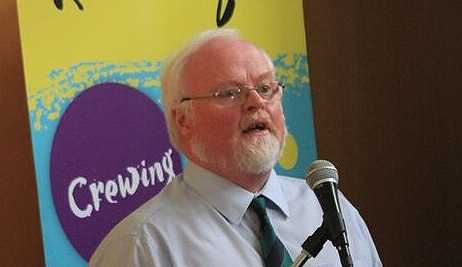
Pierce Purcell of the ISA Board outlining his innovative technique for building up a communications network of recreational boating enthusiasts around Galway Bay
So every time he sold something, he simply asked the customer if he could have their email address to keep them informed of anything that might be in the offing for boaters large and small around Galway Bay. As a result, in the last decent summer, which we had a couple of years ago if you remember, he managed to assemble a fleet of fifty-plus boats for a Bank Holiday weekend muster at Kilronan in the Aran Islands. And as a direct result of that, the WIORA Championship 2017 is going to be staged at the same venue, which will be a remarkable “first”.
The extraordinary opportunities which cruising offers for observing maritime wildlife were then outlined by Simon Berrow of the Irish Whale & Dolphin Group, and his continuing enthusiasm is at such a level that just about everyone present will be on some sort of whale watch in the season ahead.
Dr Berrow is based in Kilrush, and there’s something about the West of Ireland which sets the sailing heart afire, for we then had Daria Blackwell of Clew Bay telling us how women can get much greater enjoyment from sailing if they take steps to learn how to do it themselves, indeed the best thing is to do it well because you want to, not because some mere male needs help.

Daria Blackwell delivering the message about women adopting a more proactive role in sailing through having the most positive attitude to learning and practice. Photo: Alex Blackwell

Molly Childers on the wheel aboard Asgard in 1912. She was a much more competent helm than her husband Erskine, and it was she who made such a masterful job of steering the engine-less Asgard into Howth with a strong following wind during the gun-running episode in 1914.
This made it doubly appropriate that the conference was taking place in Howth Yacht Club, for of course in July 1914 Howth witnessed one of the finest examples of skilled helming by a woman when Molly Childers steered the engineless Asgard safely into harbour and alongside in the allotted tight berth for the Irish Volunteers Gun Running, despite a Force 5 to 6 northwest wind from dead astern.
Daria used to be the boss of a 400–employee advertising agency in New York, so when she got the sailing bug she went at it with total dedication. It made for a fascinating presentation as she outlined the different ways that men and women approach something like learning to helm a boat in confined situations.
Apparently we men rely on intuitive learning – we hope to pick it up simply by doing it. And if it involves fixing a piece of equipment, we’d rather have a blind go at it instead of RTFM. But women, according to Daria, want to learn properly - they want to practice, they’re keen to take instruction if it’s properly done, and they want to continue to get it right without feeling nervous about doing it again. Practice and self-reliance – that’s what women bring to enjoyment of sailing. And yes, they do read the manual.
Norman Kean of Courtmacsherry, Honorary Editor of the Irish Cruising Club Sailing Directions, is a typical Royal Institute of Navigation person in that, while he’s ace with all the latest equipment, he has a great love and respect for all the paraphernalia of his art, and he adores charts. But he doesn’t suffer from any illusions about the fact that some of our best-loved charts are based on data so old that a re-survey would show that some narrow channels are not quite where they’d be indicated on an electronic chart, where the original info has had to come from a paper chart.
So in an intriguing presentation he showed us some electronic anomalies of which the most vivid was the slight but crucial mis-placing of the Joyce Sound inside Slyne Head in County Galway, and then he went on to show us how much attention to detail was needed for himself and Geraldine to take their Warrior 40 Coire Uisge into Blind Harbour on Waterford’s Copper Coast.

Coffee break. Navigation guru Norman Kean (facing left) talks charts with fellow enthusiasts. Photo: W M Nixon
The organisers maintained a ferocious pace, for before we were allowed to take time for lunch, there was a break-out session with instant groups of eight or so each being formed to discuss various topics on which, at conferences end, one lucky nominee from each group had to produce a considered report. My recollection is that the problem with lobster pot marker lines loomed large, and in our group we’d the good fortune to have Paddy Judge who told us how he’d cleared a pot line which had got between his skeg and rudder – thereby disabling his steering. He’d managed to get to the lobster line by use of a short length of chain with a line at either end, the chain let over the bow with the line to each side, and then worked aft well under water until it could be used to raise the pot line, which was running vertically downwards from the rudder.
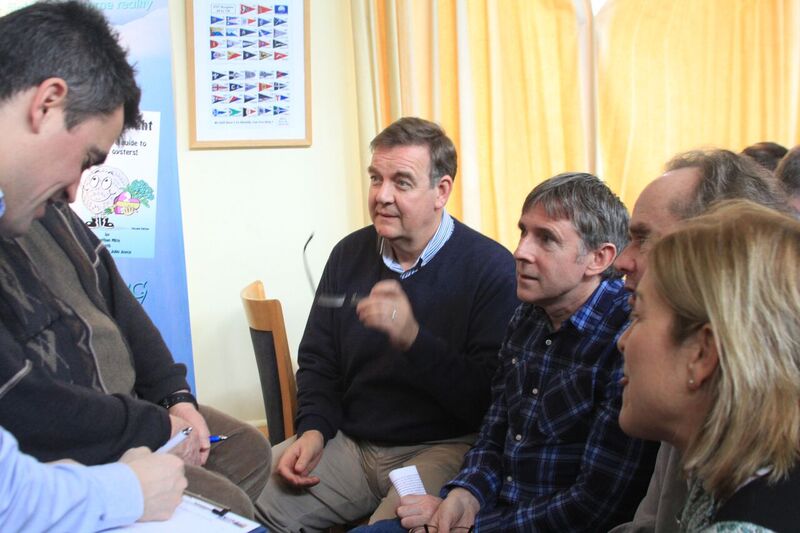
Taking a day off from the general election, RTE News Presenter Brian Dobson was one of 104 cruising and offshore sailors who took part in the ISA Conference. Photo: Alex Blackwell
The whole business of virtually unmarked pot lines all round the Irish coast is becoming such a problem that we’ll probably have a blog completely devoted to it one day. But the good news from Saturday is that the energetic Gary Davis of the HYC Cruising Group has been so determined in his lobbying of politicians and government departments regarding the menace of poorly-marked pot lines that it’s now on the official agenda, which is quite a step forward from the previous apparent indifference.
The conclusions from the break-out groups were to come at the end of the Conference, and provided food for thought with Gary Davis’s news about the new political awareness getting much approval, while there was something of a round of applause for Paddy Judge’s ingenious solution – I omitted to mention he was single-handed at the time of the incident.
The afternoon went promptly into further presentations, with CAI Commodore Clifford Brown putting out the welcome mat for newcomers in a big way. If you wanted to find a catchphrase for the entire conference, “infectious enthusiasm” would be right on target, and Commodore Brown’s exposition, cheerfully outlining the multiple choice in sailing and cruising experience which the CAI members are happy to offer to anyone even slightly interested, was encouraging to behold.
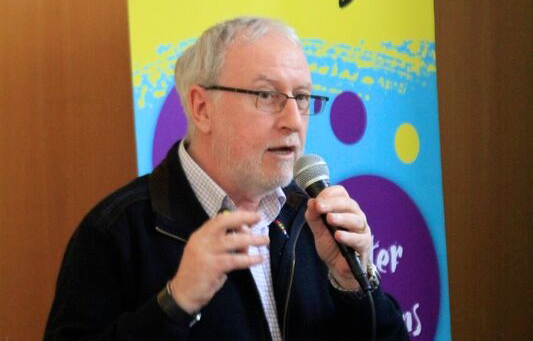
“You’re all welcome, very welcome….” Cruising Association of Ireland Commodore Clifford Brown outlines what his organisation has to offer to experienced sailors and absolute beginners alike. Photo: Alex Blackwell
A star performer. Pat Murphy’s guidance on welcoming and managing new crew drew on his unrivalled experience gained in a nine year round the world cruise. Photo: W M Nixon
However, “inspiring” is the only way to describe the next speaker. Pat Murphy has his top place for ever inscribed in Irish sailing history thanks to his fabulous nine year voyage round the world with his late wife and soulmate Olivia on their fine 40ft cutter Aldebaran. They learned much from it, and as they had guest crews aboard at regular intervals, they learned a great deal more about how to manage and welcome new crew. Pat was hugely generous in imparting nuggets of sound advice and insights culled from an exceptional cruise, and it all combined into a solid body of purest wisdom.
But then came the really serious bit. Chris Reynolds, Director of the Irish Coastguard, took us on an informative tour of his expanding organization, and guided us on the paths to sea safety and the correct course of action in an emergency. These topics had of course come up during the group discussions, where the more senior cruising folk inclined to the view that the joy of cruising is to be found in self-reliance, and if a problem arises you should take pride and satisfaction in solving it yourself, however much the potential or actual risk.

The friendly face of the rescue services – Chris Reynolds is Director of the Irish Coastguard. Photo: Alex Blackwell
But that was appropriate a long time ago, before a proper matrix of rescue and support serves was in place. You just had to be almost totally self-reliant in the old days. Yet nowadays, according to Chris Reynolds, it’s irresponsible to persist in that attitude. His message was simple. If you think you might be getting into trouble, then it’s time to alert the rescue service. For if you know you’re getting into trouble, then it may already be too late to call the rescue services.
This caused some heart-searching among traditionalists, but we hadn’t time to dwell on it, as the next speaker was the force of nature otherwise known as Vera Quinlan of INFOMAR in the Marine Institute in Galway. INFOMAR is the INtegrated Mapping FOr the sustainable development of Ireland’s MARine resource, and Vera Quinlan – a noted ocean cruising sailor in her own right – has been at the heart of it for eight years.
A Force of Nature – Vera Quinlan of INFOMAR. Photo: W M Nixon
If anyone’s interest in the future of the sea had been flagging at this stage, Vera’s enthusiasm soon fired it up again. It’s a whole new world out there, on and under the ocean, when you see it through INFOMAR eyes. And Vera’s vision for Ireland’s maritime future was just the tonic for people who sometimes tend too much to see it as no more than a playground.
The fact that she both works with it, and shows its manifold possibilities for all sorts of sustainable uses, and then goes on to sail across it for pleasure every summer - that was thought-provoking in the extreme. And so too was the concluding item, which had John Leahy, former Commodore of the CAI and a retired airline captain, and Willemien Phelan of Met Eireann in an informal competition to see who had best predicted the weather which would obtain on the day of the conference, using different forecast models in different time spans.
Both had got it pretty much spot on in their predictions a week in advance, but then we were in a spell of routine winter weather with the Great Purple Snake of Atlantis, otherwise known as the Jetstream in high speed mode, weaving across the country with one unpleasantness fairly regularly after another.
“The Great Purple Snake of Atlantis” – Willemien Phelan of Met Eireann with a particularly lurid recent swirling of the Jetstream right across Ireland. Photo: W M Nixon
Since last weekend, as you’ll have noticed the Jetstream took off for two or three days to the sunny south, which consequently wasn’t sunny any more, but Ireland certainly was. However, the Great Snake of Atlantis is due back over us today, but at least you’ll know now why the weather goes to pot when it does.
All this was only part of the wide-ranging presentation given by John and Willemien which showed just how far weather prediction has come on in recent years. The magic Ten Day Forecast may still be out of reach beyond a certain level of accuracy, but they’re closing in on the one week forecast very well indeed these days.
All of which poses a quandary for anyone organising sailing events or planning cruises. For if all the forecasts give the same message, that in a week’s time the weather is going to be plain awful with too much wind for most racing, then you’re faced with the decision of calling it off with plenty of time to spare to enable people to plan other things, or else you just stick to the programme and hope the forecast has been excessively pessimistic.
And on top of that, if several days in advance you do cancel an event whose date was set way back in the winter, when on earth are you going to slot it in later in our current programme, which is jam-packed from one weekend to the next?
But that was only one of many thoughts flying around the Conference last Saturday, and most of them were much more cheerful. The reality is cruising folk just like to get together and talk about boats and cruising until the cows come home, and if a Cruising Conference is organized with a stellar line-up of speakers, it gives it all a sense of extra purpose.
Paddy McGlade, ISA Board Member for Cruising, reviews a successful conference. Photo: W M Nixon
Long after a deservedly happy Paddy McGlade brought this part of the gathering to a conclusion after the draw for the offshore sailing suit donated by Union Chandlery had resulted in a popular win for Terry McCoy of Skerries, people were still contentedly shooting the breeze in the friendly atmosphere of the clubhouse. And the really keen ones were lining themselves up for that night’s annual dinner of the CAI. Cruising people are like that – they’re in for the long haul.

It’s all for Terry! Terry McCoy with Gail MacAllister after the Skerries sailor had won the draw for the sailing suit. Photo: Alex Blackwell
Villierstown Boating Club Attracts 25 Dinghies for Union Chandlery VB250 Pursuit Race
The sun shone down on Villierstown Boating Club on September 6th for the inaugural VB250 pursuit race for 25 dinghy sailing crews sponsored by Union Chandlery. Competitors arrived from the local club, Youghal SC, Dungarvan Harbour SC and Greystones SC in wicklow. The fleet prepared for challenging light winds and the ebb and flow of the picturesque river Blackwater. The race got underway promptly at 12pm with the Topaz UNOs setting the pace. Hot on their transoms came the Topaz DUOs, a Gaff rigged Sailing Cob, the beautiful Dublin Bay Mermaid Akita, GP14s, Wayfarer's and the Laser 16 of Gareth Higgins. By 12:25pm the entire fleet was underway and the chase had begun.
Half an hour of racing passed before two of the GP14s crewed by Adrian Lee and Ed Coyne and Jordan Lupton and Norman Lee managed to battle through the fleet and overhaul the Topaz UNO of Barry Morrissey to take the race lead close to the first mark near to Dromana House. These two highly experienced GP14 crews, who have honed their skills at national and international events, gradually pulled out an unassailable lead. The only question for the crowds on Villierstown quay: Who will win? Never more than 3 boat lengths separated the two GP14s and the lead changed many times. It was nail-biting stuff!
The racing amongst the rest of the competitors remained tight too. The boats and crews were well matched and the concentration to eek out every knot of speed to get the edge was intense. For most at least! It was noted by the race committee that a number of competitors decided to focus on family fun and picnics were concealed on-board several boats, which were enjoyed as the fleet glided to the mark off Strancally Castle.
After 3 hours of great racing and family entertainment, the finishing line was laid and the race positions determined. After a great battle between the GP14s a dramatic moment right on the finishing line nearly cost Adrian Lee the race. However, some fine sportsman ship from Jordan Lupton and Norman Lee enabled Adrian Lee and Ed Coyne to secure 1st place and become the first winners of the first VB250 pursuit race.
To round off a fabulous day VBC laid on a BBQ for all the competitors and families. Then prizes, kindly sponsored by Union Chandlery, were awarded by the Union Chandlery supremo, Peter Burke, also a competitor in the race. Awards were:
1st Adrian Lee & Ed Coyne - GP14
2nd Jordan Lupton & Norman Lee - GP14
3rd Barry Morrissey - Topaz UNO
4th Alex Ballot - Sailing Cob
5th Eugene Burke, Eoghan Burke, Shane Buckley - Dublin Bay Mermaid
1st Helm U18 - Jordan Lupton
1st Lady - Ella Crowe
Best family effort - Maisie and Pippa Burke
Best Juniors - Aidan and Eabha Higgins
Fastest Rigging - Tiernan Beresford"
Royal Cork's Neil Hogan Crowned 1720 European Champion
The Union Chandlery sponsored 1720 European Championships were held at the Royal Cork Yacht Club last weekend with Neil Hogan’s “Micam”, helmed by Mel Collins being crowned champion. The Durcan/Higgins’ owned T-Bone (helmed by David Kenefick) was second and Anthony O’Leary’s “Antix” was third. Day three event photos by Bob Bateman are here.
Race Officer Peter Crowley gave the fleet 10 fantastic races over three days, with the windward/leeward course being set two miles South East of Roches Point each day in it what were generally northerly winds.
Neil Hogan’s “Micam” really stole the show at this event counting a 3, 1, 1, on day one, a 1, 2, 1 on day two and two thirds on the final day, discarding his last race.
The fleet were treated to a harbour tour on the Thursday evening, courtesy of Peter Crowley and Anthony O’Leary and enjoyed a very sociable visit to Cobh and Monkstown.
The next port of call for the sportsboat class is Royal Cork's Autumn league.
Union Chandlery Foynes Laser Spring Series Concludes
#shannonestuary – Foynes Yacht Club's dinghy fleet has been undergoing something of a revival in the past 6 months. For the first time in a number of years the club has continued sailing throughout the winter and has just concluded the Laser Spring Series which ran throughout February and March.
20 competitors in total took part over the 9 weeks with an average of 14 boats out each week. Given the mixed weather conditions at this time of year the fleet allowed for some flexibility with regard to racing on Saturdays or Sundays with aim of getting out on the water as many weeks as possible. The organising group made the call each Thursday evening and the result was racing 7 out of the 9 weeks and 16 out of the scheduled 18 races taking place. There were 5 new additions to the laser fleet this spring and they certainly didn't get the easiest introduction to dinghy racing. Huge credit goes to each of them, in particular the juniors as young as 14 years, for coming out every week.
They all agree they've pretty much mastered the skill of capsizing and righting the boat again at this stage!
At the prizegiving presentation Laser Class Captain Cathal McMahon thanked Union Chandlery in Cork, the main sponsors, for their generous prizes. He also thanked the OOD's & rescue crews and Reidy's Centra in Foynes & Clifford's Cash and Carry in Tralee for sponsoring the much appreciated soup and rolls after racing.
The club have been liaising with other clubs along the west coast to promote dinghy sailing and had a number of visiting boats from Tralee Bay Sailing Club for the series. As a follow on 10 boats from FYC have travelled to Tralee as they get their dinghy season up and running with an April Series running over the next four weeks.
FYC will also hold an Open Dinghy Regatta on Saturday May 23rd & Sunday May 24th and hope to see sailors from a few more clubs at what promises to be a 'competitive' but 'fun' event.
Cork Harbour 'Mid-Summer Madness' Attracts 40 Boats
Adrielle was on station in her refurbished state with the crew still putting finishing touches to the portholes and mighty fine she looked too. Martin Almond and the Race Team sent the cruisers on course 93, two rounds for Class One and one for the other classes plus a course for the Whitesail fleet that included a beat out to number 6. As that fleet came around number 6 they were met by the other fleets coming in the harbour and it was nearly as busy as Piccadilly Circus. Nobody minded as they had a lovely 6 to 8 kts southerly breeze to make for very enjoyable sailing and made the most of the evening.
Aprés sailing there was a rush to get back to the club, for once not to have to get in out of the weather but this time the rush was to grab a seat and enjoy their barbeque food in the outside Patio dining area. I hasten to add the club was also jammed to the hilt as the sailors awaited the call to announce results and prize giving. While waiting the sound of great live music floated over Crosshaven and it was just one tremendous summer evening of sailing and fun.
At last the moment arrived and Vice Admiral Peter Deasy sounded the call to arms and Rear Admiral Ronan Enright warned anyone not present outside for the prize giving would not be considered for the draw for the Marine Motors engine which prompted a dash to the patio area. After the Leagues prize giving three tickets were drawn. Tim O'Mahony from the O'Shea/Durcan T Bone, Michael Wallace of Felix and Derry Nash of Catalpa were the tree names. Two of the three would get bottles of champagne with the last remaining name getting the engine. Derry Nash turned out to be the lucky punter and was thrilled with his luck on the night.
Next Thursday night a new sponsor, the very well known Timberland, will be on board for the July league. Racing will take place on July 7th, 14th, 21st and 28th. The company is offering a 20% discount on their products for RCYC members on production of their membership cards.
Thistle Takes Cork Harbour Race
Peter Webster's Hustler 25 'Thistle' was first home in last night's White Sail Division of Royal Cork's Union Chandlery June league.
Cork Harbour racing last night started an hour after low water. Winds were north–westerly averaging 12 knots with a few surprise gusts.
The fleet was somewhat depleted for the June League, because a number of the boats were competing in Kinsale for the Sovereign's Cup.
In Class three first place went to John and Fiona Murphy's Impala 28 'Fast Buck', in Class 2 it was Kieran and Liz O'Brien's MG335
'Magnet' and in Class 1 it was Mary O'Keefe's X332 'Tux'.



























